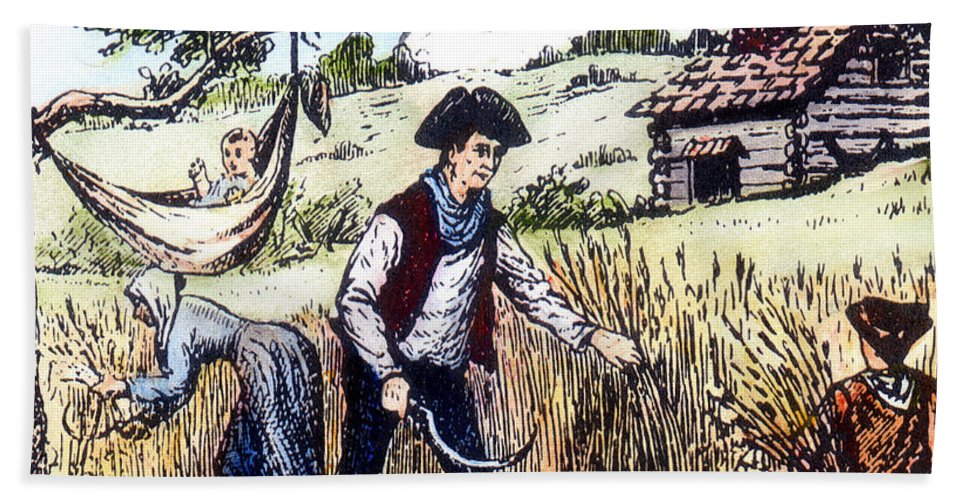![]() Introduction:
Introduction:
What would it be like not having the Extension Service to call on when you had a question about agriculture? What if agricultural classes were not taught in the local high school? The early settlers in America did not have these resources. Yet, a knowledge of agriculture was critical to their survival. So, who did they rely on for agricultural knowledge? Was this knowledge accurate? What was done to promote the study of agriculture? Did formal education have any role in agricultural education? Which colony had a plan for agricultural education/extension? In this lesson, we will learn more about the state of agriculture and education prior to 1862.
![]() Lesson Objectives:
Lesson Objectives:
At the completion of the lesson you should be able to:
- Describe the level of agricultural knowledge possessed by colonists at Jamestown and Plymouth
- Identify sources of agricultural knowledge utilized by settlers in Jamestown and Plymouth
- Discuss the process of formal schooling in the Massachusetts Bay Colony
- Explain the three components of the agricultural education/extension plans used in the Georgia Colony.
- Define Lyceum and explain how they contributed to the development of agricultural and domestic arts knowledge in early America.
- Identify the origins of the agricultural fair and how it was involved in education.
- Describe how agricultural societies promoted the development of new knowledge in agriculture.
- Identify early agricultural periodicals and assess the accuracy of the information they presented.
- Differentiate between academies and high schools in the early days of American education.
- Describe the role of higher education in promoting scientific knowledge prior to 1862.
![]() Assignment:
Assignment:
The American Farmer was a magazine published in Baltimore starting in 1819. It was in existence for more than 50 years. It published articles on agriculture and domestic science. Many rural families depending upon this and similar publications to be a source of knowledge regarding agriculture and domestic science. Your assignment is to peruse the magazine and select one article, letter to the editor, etc. to discuss. Basically, we are trying to ascertain how accurate, valid, and scientific the information is in early agricultural publications. Try to pick an article that you think is quackery (in other words there is no scientific basis for what is being reported). Again, the purpose of this assignment is to expose you to the “level of knowledge” that existed for agriculture and domestic arts in the early 1800s. The American Farmer has been digitized and can be accessed at https://earlyushistory.net/american-farmer/. A couple of interesting articles are found on pages 242 and 267 of Volume 2. I will ask for volunteers to share what they found at the start of the class next week.
If you want the joy of experiencing “book dust” and are on campus, you can request to see actual original copies of the American Farmer. These old 1830 and 1840 era magazines were actually in the stacks at the D. H. Hill Library but have been moved to the Hunt Library on Centennial Campus. You can request to see the originals in the Hunt Library.
![]() The PowerPoint Presentation Used with the Lesson (in PDF format):
The PowerPoint Presentation Used with the Lesson (in PDF format):
A pdf file with the PowerPoint Presentation used in this lesson can be downloaded from this link.
![]() Additional Resources for Enrichment Purposes:
Additional Resources for Enrichment Purposes:
- The first European settlers to the New World came to Jamestown. Watch this video about the Jamestown Colony to see how prepared the settlers were for the new world. What was the turning point?
- Read Thomas Wessel’s article “Agriculture, Indians, and American History” from the January 1976 issue of Agricultural History. Focus on the first part of the article.
- Visit the Colonial Education section of the History of American Education web site.
- Read William Brewer’s article “Agricultural Societies, What They Are and What They Have Done.“. This article was published in the Annual Report for 1880-81 of the Connecticut Board of Agriculture.
- The oldest agricultural society in the United States is the Philadelphia Society for Promoting Agriculture. It is still in existence today. Spend some time browsing their web site. http://pspaonline.com/history/overview/
- The early fairs often served an educational purpose. Learn more about fairs. https://www.arcadiapublishing.com/Navigation/Community/Arcadia-and-THP-Blog/August-2018/American-Traditions-A-Short-History-of-Agricultur
- In addition to agricultural societies and fairs, there was an assortment of farm publications (newspapers) designed to educate the farmers in the early days in America. The Agricultural Museum was one such publication.
